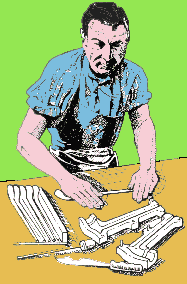 The
clay was washed in wooden or copper tubs to remove dirt and stones
and placed on boards to mature and dry.
The
clay was washed in wooden or copper tubs to remove dirt and stones
and placed on boards to mature and dry.
 The
clay was washed in wooden or copper tubs to remove dirt and stones
and placed on boards to mature and dry.
The
clay was washed in wooden or copper tubs to remove dirt and stones
and placed on boards to mature and dry.
When dry, the clay was worked by beating with an iron bar to remove air bubbles.
Balls of clay were rolled by hand and afterwards rolled out to form the rough shape of the pipe to be moulded. These were called "rolls".
![]() A
piercing rod was passed through the shank of a roll which was placed
in a two-piece metal mould.
A
piercing rod was passed through the shank of a roll which was placed
in a two-piece metal mould.
 The
assembled mould was placed in a gin press and the lever pulled down
to force the bowl-forming rod into the clay. The piercing rod was
removed and the pipe removed from the mould.
The
assembled mould was placed in a gin press and the lever pulled down
to force the bowl-forming rod into the clay. The piercing rod was
removed and the pipe removed from the mould.
![]() When
the pipes were dry, any rough edges were removed with a trimming
knife and the pipes placed in saggers ready for firing.
When
the pipes were dry, any rough edges were removed with a trimming
knife and the pipes placed in saggers ready for firing.
 The
saggers were then stacked in the kiln and fired to about 950 degrees
Celcius.
The
saggers were then stacked in the kiln and fired to about 950 degrees
Celcius.
 After
firing, the pipes were checked for flaws and the mouthpieces coated
with wax or laquer to prevent the smoker's lips from sticking to the
clay.
After
firing, the pipes were checked for flaws and the mouthpieces coated
with wax or laquer to prevent the smoker's lips from sticking to the
clay.
This Web Site was produced entirely on a Macintosh Computer.
![]()